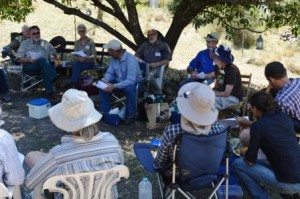Field day at Cootaame, Trevor Tops Rd and Upper Monkerai on 13th October 2013
Twenty three members and non-members gathered at two properties on a hot day to discuss appropriately hazard reduction. Kevin Carter, who had experience in National Parks, led the discussion. Hazard reduction is to preserve or protect assets such houses or buildings and includes keeping the property clear of vegetation through slashing. The direction and slope of the land will determine how many metres are required.
If there are more the 5 tons and less than 25 tons per hectare of under growth amongst trees, the fuel load, then a controlled burn may help. This requires advice from Rural Fire Service, notifying neighbours, ensuring the weather forecast is stable with temperature less than 25 degrees, humidity greater than 50%, and wind less than 15 km per hour, ensure easy access, that the controlled burning is contained and burn downhill. The leaf test can be used to measure humidity: leaf should burn when horizontal, but not when help upright.
Kevin also pointed out that there is a need to preserve trees with hollows, rain forest or riparian zones and some species do not resist fire (flooded gums). It is necessary to clear around these trees to ensure that they are safe. Smooth bark trees, white mahogany and iron bark are resistant to fire.
On inspecting the 2 properties, the first was well cleared, although from the West, the National Park over the road was the greatest threat. The second was also safe since the fuel load was low, and rain washes fallen leaves down into the creek.
With the problem of increasing and more severe fires this was a valuable education for members.
At lunch the AGM was held and Craig Tate accepted the position of President, and 2 new committee members were elected: Fred Fetherson and Nick Cameron. Below the new President addressing the members.
